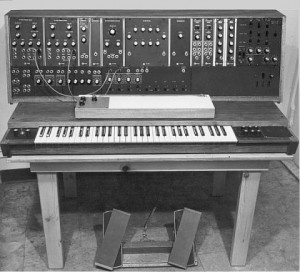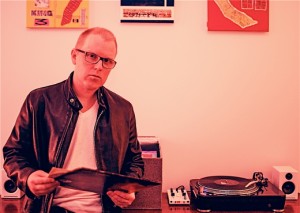The ABC’s of…Electronic Rock in the Studio: The Doors to Depeche Mode & LCD Soundsystem
The fourth in a series, presenting a primer on the history of musical genres and the studio basics behind them. Previous installments have focused on Blues Rock, Reggae, and Punk Rock.
A musical revolution starts with a simple idea and transforms into a genre that fans all over the world can embrace as a scene that lives on for decades on end.

A Moog Modular synth circa 1965 — a big part of what started it all (photo courtesy of http://www.moogmusic.com).
This is what happened to the already changing rock and roll scene with the introduction of the synthesizer in the late 1960’s – a development that gave birth to the vast genre known as electronic rock. A genre founded on digital experimentation, electronic rock (which was originally distinguished as progressive or prog-rock) has allowed new distinct and revolutionary acts to gain popularity almost instantly.
The studio has played a major role in this genre’s upbringing and its current industry attention. Production and mastering have always been essential in isolating and amplifying these electronic sounds in a powerful way to blast a listener with something energetic and refreshing that keeps them coming back for more.
Early Circuits
Musicians and classic rock pioneers like Ray Manzarek of The Doors, Pink Floyd, Yes, and Mike Pinder of The Moody Blues were instrumental in the formation of the genre, utilizing the Moog synthesizer to complement their band’s catchy rock songs.
Music sampling and tape manipulation started to become popular, with use of early technological developments like the Mellotron. The Mellotron was most notably initially implemented in songs like The Beatles’ “Strawberry Fields Forever.”
With no defined border or boundary, there was a lot of leg room for musicians to now branch out into industrial rock, synth pop, dance-punk and indietronica. In the ’70s, the electronic revolution extended its reach into jazz: A prominent example of this was Herbie Hancock’s significant “Head Hunters” LP series.

Groups like Rush and Van Halen were now taking the use of synthesizers in rock to new heights and began headlining some of the largest arenas in the U.S., setting the precedent for other notable electronic rock acts. As Manzarek once said, “I thought we were gonna open up the world of poetry and music to all kinds of things, and yet, I can’t really think of anyone who’s done anything like it since.”
In a way he was right, the pioneers did open the door for electronic expression, which transformed into many other sounds and styles, but no one replicated what The Doors did. Other bands simply took their lead and did something different with it. The transition was smooth. It almost seemed like music fans were ready and waiting for it – and that’s how these genres remain in the spotlight today.
Rock the Technique
Electronic rock songs tend to either be mellow or upbeat, with echoing yet clean vocals. However, there are many instances where solely instrumental tracks suffice. Although synthesizers have always been the main form of electronic artistic expression, tannerins, theremins and later electronic drums were also implemented.
Later in the ’70s, new wave artists like Gary Numan, Kraftwerk and Ultravox were coming out on top of the scene, implementing all kinds of innovative synth-like devices. MIDI technology, which came about in the late 1980s, added further sophistication to the way different sounds could be merged with each other, giving an already experimental genre the ability to intensify in complexity. Bands like Britain’s Depeche Mode and New Order took synthpop to a new mainstream level, reaching the masses who were now jumping on board.
By the mid-late ’90s, the formation of what is now considered as our current mainstream was in the hands of some of the best producers to date, including William Orbit who helped Madonna create her smash LP “Ray of Light.” Around the same time, Moby unleashed the multi-million selling album “Play,” an LP of almost entirely electronic and production-based tracks. Soon after, Prodigy’s eclectic album “The Fat of The Land” was a chart topper.

These stunning albums, which were produced and mixed to such a high standard don’t fade, and as of last year, Prodigy’s record had sold over 10 million copies worldwide.
Bands like LCD Soundsystem had everyone’s attention with their catchy and powerful music. Often, electronic rock artists are very well-versed in self-production and now former LCD Soundsystem frontman James Murphy helps artists like Arcade Fire, the Yeah Yeah Yeahs and David Bowie implement electronic manipulation into their indie tracks during the songwriting process and in the studio.
Nine Inch Nails, who claim more industrial rock, often dabble in laptronica (use of laptop) and after just reuniting have been selling out some of the largest U.S. venues. Their frontman, Trent Reznor, has also aided in producing albums like Dave Grohl’s “Sound City – Reel to Real.”
Guitar and/or drums are often eschewed by many electronic rock artists, who strictly rely on technology to put out their DJ/rock-themed material. Computer technology has allowed emerging artists, like Black Moth Super Rainbow, Anamanaguchi & André Obin just to name a few, to put out quality in-home recordings for release online. The Internet has allowed new artists to gain enough attention to become relevant, and get into a studio where their product can get some additional quality control.
Engineer’s Guide: The Studio Essentials
Sky Council Recording’s owner/engineer/producer/artist T.H. White commented on the keys to isolating the electronic rock genre in the studio:
“With all the easily accessible technology and laptop producers out there, it’s often assumed that electronic-based music, be it dance, rock or chill-out, is now ‘easy to create,’” White says. “That may be true at a base level, but the successful and respected producers are all excellent engineers as well. As the head of the Sky Council label, we receive submissions all the time where the ideas are cool, but the recordings clearly sound amateur, small and ‘in the box’ as we call it.
“To really make electronic elements in music work, we feel it needs to be combined with traditional high end tracking, mixing and mastering. Meaning lots of analog outboard gear, tube EQ, and high end microphones for tracking and mixing. And, professional mastering, not a ‘pre-set’ plug-in. The way great lengths are gone to in the studio to make a traditional rock, classical or R&B record, the same goes for electronic.
“For example, if you are using a drum machine, the individual hits need to be separated, treated with high end saturation and properly mixed into the track. Fans and producers today can identify the difference, and the availability of easy-to-use all-in-one software isn’t going to cut it alone. Listen to a Deadmau5, Kaskade, Gorrillaz or Pretty Lights LP: They are all masterfully textured to achieve a glossy timeless feel. There is a reason why you drop the needle on a Gary Numan LP today and it sounds rich and beautiful, whereas many of the early 2000’s ‘electronica’ acts have quickly slipped into obscurity…”
Programming the Future
The reach of electronic rock has been profound and it seems like a genre that will stick around and only improve with time. We live in an era in which we’re lucky to still be able to see some of the innovators perform. With talented producers becoming artists themselves, and artists becoming talented producers, it’s clear that electronic rock has a long lifespan still ahead.
What gadget will launch the genre into its next phase of development? What new artist will surprise us all? Stick around, you’re in for quite the digital ride.
Please note: When you buy products through links on this page, we may earn an affiliate commission.








Harry
March 4, 2014 at 12:26 am (11 years ago)MIDI was standardized in 1983, not the late ’80s as this article states.